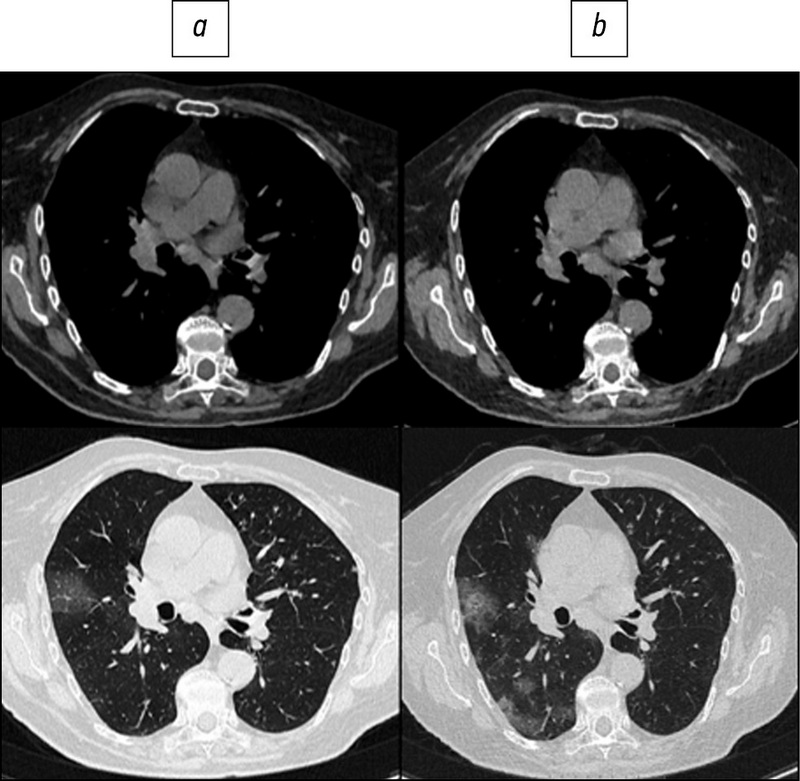在计算机断层扫描期间减少辐射负荷以评估COVID-19肺特性变化的可能性:使用自适应统计迭代重建
- 作者: Filatova D.A.1, Sinitsin V.E.1, Mershina E.A.1
-
隶属关系:
- Lomonosov Moscow State University
- 期: 卷 2, 编号 2 (2021)
- 页面: 94-104
- 栏目: 原创性科研成果
- URL: https://journals.rcsi.science/DD/article/view/62477
- DOI: https://doi.org/10.17816/DD62477
- ID: 62477
如何引用文章
详细
论证大多数COVID-19患者在住院期间接受多次成像检查,其累积效应可以显着增加接受的辐射总剂量。有效辐射剂量可以通过降低x射线管的电流和电压来降低,然而,这会降低图像质量。这个问题的一个可能的解决方案是引入自适应统计迭代重建 (Adaptive Statistical Iterative Reconstruction (ASIR))技术,用于计算机断层扫描(CT)的»原始数据»的自适应统计迭代重建。最近,有关低剂量CT(LDCT)有效性的信息已经出现在COVID-19诊断中的文献中。
目的是在应用迭代处理算法后分析肺部LDCT图像的质量和诊断价值,以评估在COVID-19诊断期间减少患者辐射负荷的可能性。
材料与方法。这项前瞻性研究涉及在罗蒙诺索夫莫斯科国立大学医学中心传染病部门接受住院治疗的患者。CT研究在入院和出院时进行; 在住院期间,根据临床需要重复进行。在第一项研究中,使用120kV管电压和200-400mA范围内的自动电流调制的标准CT协议,通过重复CT扫描的时候,LDKT协议使用管电压(100或110kV)和40-120mA范围内的自动电流调。为了评估LDCT与标准CT相比的诊断价值,在莫斯科国立大学医学中心辐射诊断系的医生中进行了问卷调查。调查问卷包括两种方法的比较描述,用于检测这种病理过程,如通过磨砂玻璃类型压实肺组织,通过磨砂玻璃类型压实具有网状变化,肺组织固结区域,淋巴结病。
结果该研究涉及151名患者;平均年龄为58±14.2岁;男性为53.6%。使用LDCT,与标准CT相比,辐射负荷平均下降2.96倍,计算机断层扫描剂量指数(CTDI)―2.6倍,平均吸收剂量(DLP)―3.1倍,管上的电流―1.83倍,管上的电压-1.2倍。获得的问卷数据表明,在LDCT期间,与根据标准协议进行的CT相比,检测病毒性肺炎的主要体征和评估患者病情动态的有效性没有显着变化。
结论比较标准的CT和LDCT的结果表明,在辐射负荷降低的情况下,诊断信息和质量没有显着损失。因此,胸部的LDCT扫描可以在常规实践中用于成功诊断COVID-19。
关键词
作者简介
Daria A. Filatova
Lomonosov Moscow State University
编辑信件的主要联系方式.
Email: dariafilatova.msu@mail.ru
ORCID iD: 0000-0002-0894-1994
SPIN 代码: 2665-5973
Medical Research and Educational Center
俄罗斯联邦, 1a Shkolnaya street, 143430 Nakhabino, Moscow regionValentin E. Sinitsin
Lomonosov Moscow State University
Email: vsini@mail.ru
ORCID iD: 0000-0002-5649-2193
SPIN 代码: 8449-6590
MD, PhD, Professor, Medical Research and Educational Center
俄罗斯联邦, MoscowElena A. Mershina
Lomonosov Moscow State University
Email: elena_mershina@mail.ru
ORCID iD: 0000-0002-1266-4926
SPIN 代码: 6897-9641
MD, PhD, Associate Professor, Medical Research and Educational Center
俄罗斯联邦, Moscow参考
- Ministry of Health of the Russian Federation. Temporary guidelines: prevention, diagnosis and treatment of new coronavirus infection. Version 8 (03.09.2020). Moscow; 2020. (In Russ). Available from: https://base.garant.ru/74596434/
- Romanov BK. Coronavirus infection COVID-19. Safety and Risc of Farmacotherapy. 2020;8(1):3–8. (In Russ.)
- Morozov SP, Protsenko DN, Smetanina SV, et al. Radiation diagnostics of coronavirus disease (COVID-19): organization, methodology, interpretation of results: preprint No. CDT-Version 2 of 17.04.2020. Moscow; 2020. 78 р. (In Russ.)
- Udugama B, Kadhiresan P, Kozlowski HN, et al. Diagnosing COVID-19: the disease and tools for detection. ACS Nano. 2020;14(4):3822–3835. doi: 10.1021/acsnano.0c02624
- Zhao W, Zhong Z, Xie X, et al. Relation between chest ct findings and clinical conditions of coronavirus disease (COVID-19) pneumonia: a multicenter study. AJR Am J Roentgenol. 2020;214(5):1072–1077. doi: 10.2214/AJR.20.22976
- Beregi JP, Greffier J. Low and ultra-low dose radiation in CT: Opportunities and limitations. Diagn Interv Imaging. 2019;100(2):63–64. doi: 10.1016/j.diii.2019.01.007
- Cheng L, Chen Y, Fang T, et al. Fast iterative adaptive reconstruction in low-dose CT imaging. In: 2006 International Conference on Image Processing. Atlanta, GA: IEEE; 2006. P. 889–892. Available from: https://ieeexplore.ieee.org/document/4106673/
- Hara AK, Paden RG, Silva AC, et al. Iterative reconstruction technique for reducing body radiation dose at CT: feasibility study. AJR Am J Roentgenol. 2009;193(3):764–771. doi: 10.2214/AJR.09.2397
- Prakash P, Kalra M, Kambadakone A, et al. Reducing abdominal CT radiation dose with adaptive statistical iterative reconstruction technique. Invest Radiol. 2010;45(4):202–210. doi: 10.1097/RLI.ob013e3181dzfeec
- Chen LG, Wu PA, Sheu MH, et al. Automatic current selection with iterative reconstruction reduces effective dose to less than 1 mSv in low-dose chest computed tomography in persons with normal BMI. Medicine (Baltimore). 2019;98(28):e16350. doi: 10.1097/MD.0000000000016350
- Dangis A, Gieraerts C, De Brueker Y, et al. Accuracy and reproducibility of low-dose submillisievert chest CT for the diagnosis of COVID-19. Radiology Cardiothoracic Imaging. 2020;2(2):e200196. doi: 10.1148/ryct.2020200196
- Sethuraman N, Jeremiah SS, Ryo A. Interpreting diagnostic tests for SARS-CoV-2. JAMA. 2020;323(22):2249–2251. doi: 10.1001/jama.2020.8259
- Long C, Xu H, Shen Q, et al. Diagnosis of the Coronavirus disease (COVID-19): rRT-PCR or CT? Eur J Radiol. 2020;126:108961. doi: 10.1016/j.ejrad.2020.108961
- Fang Y, Zhang H, Xie J, et al. Sensitivity of chest CT for COVID-19: comparison to RT-PCR. Radiology. 2020;296(2):E115–E117. doi: 10/1148/radiol.2020200432
- Yang Y, Yang M, Shen C, et al. Evaluating the accuracy of different respiratory specimens in the laboratory diagnosis and monitoring the viral shedding of 2019-nCoV infections. medRxiv. 2020. doi: 10.1101/2020.02.11.20021493
- Brenner DJ, Hall EJ. Computed tomography--an increasing source of radiation exposure. N Engl J Med. 2007;357(22):2277–2284. doi: 10.1056/NEJMra072149
- Pierce DA, Preston DL. Radiation-related cancer risks at low doses among atomic bomb survivors. Radiat Res. 2000;154(2):178–186. doi: 10.1667/0033-7587(2000)154[0178:rrcral]2.0.co;2
- Matkevich E, Sinitsyn V, Mershina E. Comparative analysis of radiation doses of patients with computed tomography in a Federal medical institution. Journal of Radiology and Nuclear Medicine. 2016;97(1):33–39. (In Russ). doi: 10.20862/0042-4676-2016-97-1-33-40
- Naidich DP, Marshall CH, Gribbin C, et al. Low-dose CT of the lungs: preliminary observations. Radiology. 1990;175(3):729–731. doi: 10.1148/radiology.175.3.2343122
- Prasad SR, Wittram C, Shepard JA, et al. Standard-dose and 50%-reduced-dose chest CT: comparing the effect on image quality. AJR Am J Roentgenol. 2002;179(2):461–465. doi: 10.2214/ajr.179.2.1790461
- Zwirewich CV, Mayo JR, Müller NL. Low-dose high-resolution CT of lung parenchyma. Radiology. 1991;180(2):413–417. doi: 10.1148/radiology.180.2.2068303
- Zhu X, Yu J, Huang Z. Low-dose chest CT: optimizing radiation protection for patients. AJR Am J Roentgenol. 2004;183(3):809–816. doi: 10.2214/ajr.183.3.1830809
- Kubo T, Ohno Y, Takenaka D, et al. Standard-dose vs. low-dose CT protocols in the evaluation of localized lung lesions: Capability for lesion characterization – iLEAD study. Eur J Radiol Open. 2016;3:67–73. doi: 10.1016/j.ejro.2016.03.002
- Gombolevsky VA, Chernina VY, Blokhin IA. Main achievements of low-dose computed tomography in lung cancer screening. Tuberculosis and Lung Diseases. 2021;99(1):61–70. (In Russ). doi: 10.21292/2075-1230-2021-99-1-61-7025.
- Rampinelli C, De Marco P, Origgi D, et al. Exposure to low dose computed tomography for lung cancer screening and risk of cancer: secondary analysis of trial data and risk-benefit analysis. BMJ. 2017;356:j347. doi: 10.1136/bmj.j347
- Chiles C. Lung cancer screening with low dose CT. Radiol Clin North Am. 2014;52(1):27–46. doi: 10.1016/j.rcl.2013.08.006.















